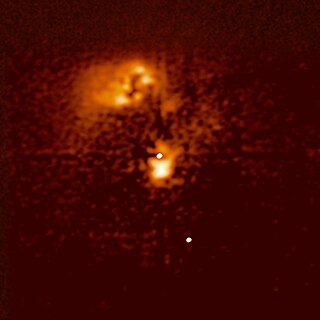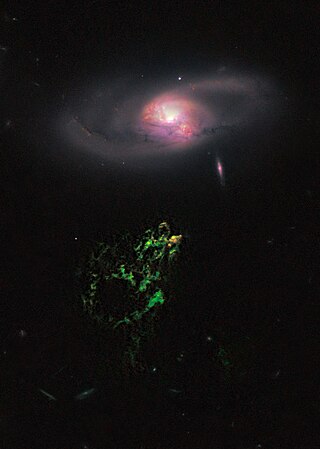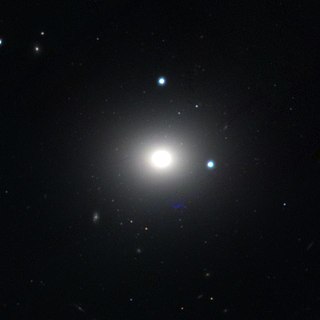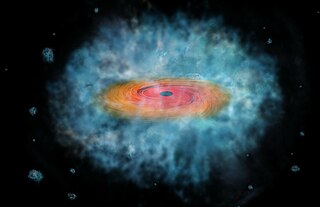
A quasar is an extremely luminous active galactic nucleus (AGN). It is sometimes known as a quasi-stellar object, abbreviated QSO. The emission from an AGN is powered by a supermassive black hole with a mass ranging from millions to tens of billions of solar masses, surrounded by a gaseous accretion disc. Gas in the disc falling towards the black hole heats up and releases energy in the form of electromagnetic radiation. The radiant energy of quasars is enormous; the most powerful quasars have luminosities thousands of times greater than that of a galaxy such as the Milky Way. Quasars are usually categorized as a subclass of the more general category of AGN. The redshifts of quasars are of cosmological origin.

Messier 87 is a supergiant elliptical galaxy in the constellation Virgo that contains several trillion stars. One of the largest and most massive galaxies in the local universe, it has a large population of globular clusters—about 15,000 compared with the 150–200 orbiting the Milky Way—and a jet of energetic plasma that originates at the core and extends at least 1,500 parsecs, traveling at a relativistic speed. It is one of the brightest radio sources in the sky and a popular target for both amateur and professional astronomers.

A supermassive black hole is the largest type of black hole, with its mass being on the order of hundreds of thousands, or millions to billions, of times the mass of the Sun (M☉). Black holes are a class of astronomical objects that have undergone gravitational collapse, leaving behind spheroidal regions of space from which nothing can escape, not even light. Observational evidence indicates that almost every large galaxy has a supermassive black hole at its center. For example, the Milky Way galaxy has a supermassive black hole at its center, corresponding to the radio source Sagittarius A*. Accretion of interstellar gas onto supermassive black holes is the process responsible for powering active galactic nuclei (AGNs) and quasars.

A mass deficit is the amount of mass that has been removed from the center of a galaxy, presumably by the action of a binary supermassive black hole.

HE0450-2958 is an unusual quasar. It has been called the "naked quasar" and the "quasar without a home" because it appears to lack a host galaxy. It is estimated to lie approximately one billion parsecs away.

APM 08279+5255 is a very distant, broad absorption line quasar located in the constellation Lynx. It is magnified and split into multiple images by the gravitational lensing effect of a foreground galaxy through which its light passes. It appears to be a giant elliptical galaxy with a supermassive black hole and associated accretion disk. It possesses large regions of hot dust and molecular gas, as well as regions with starburst activity.

The Andromeda–Milky Way collision is a galactic collision predicted to occur in about 4.5 billion years between the two largest galaxies in the Local Group—the Milky Way and the Andromeda Galaxy. The stars involved are sufficiently far apart that it is improbable that any of them will individually collide, though some stars will be ejected.

Hanny's Voorwerp, is a rare type of astronomical object called a quasar ionization echo. It was discovered in 2007 by Dutch schoolteacher Hanny van Arkel while she was participating as a volunteer in the Galaxy Zoo project, part of the Zooniverse group of citizen science websites. Photographically, it appears as a bright blob close to spiral galaxy IC 2497 in the constellation Leo Minor.
The Cloverleaf quasar is a bright, gravitationally lensed quasar.
A hypercompact stellar system (HCSS) is a dense cluster of stars around a supermassive black hole that has been ejected from the center of its host galaxy. Stars that are close to the black hole at the time of the ejection will remain bound to the black hole after it leaves the galaxy, forming the HCSS.

SDSS J0927+2943 is an unusual quasar. It exhibits two sets of optical emission lines with different redshifts. The origin of the two emission line systems is believed to be a gravitational wave recoil event: the ejection of a supermassive black hole from the center of the host galaxy. In this interpretation, one of the emission line systems originates in gas that is bound to the black hole, while the other set is associated with gas that remains in the galaxy.

A binary black hole (BBH), or black hole binary, is a system consisting of two black holes in close orbit around each other. Like black holes themselves, binary black holes are often divided into stellar binary black holes, formed either as remnants of high-mass binary star systems or by dynamic processes and mutual capture; and binary supermassive black holes, believed to be a result of galactic mergers.
Manuela Campanelli is a distinguished professor of astrophysics and mathematical sciences of the Rochester Institute of Technology, and the director of its Center for Computational Relativity and Gravitation and Astrophysics and Space Sciences Institute for Research Excellence. Her work focuses on the astrophysics of merging black holes and neutron stars, which are powerful sources of gravitational waves, electromagnetic radiation and relativistic jets. This research is central to the new field of multi-messenger astronomy.

A nuclear star cluster (NSC) or compact stellar nucleus is a star cluster with high density and high luminosity near the center of mass of most galaxies.

NGC 1395 is an elliptical galaxy located in the constellation Eridanus. It is located at a distance of circa 75 million light years from Earth, which, given its apparent dimensions, means that NGC 1395 is about 130,000 light years across. It was discovered by William Herschel on November 17, 1784. It is a member of the Eridanus Cluster.

Direct collapse black holes (DCBHs) are high-mass black hole seeds, putatively formed within the redshift range z=15–30, when the Universe was about 100–250 million years old. Unlike seeds formed from the first population of stars (also known as Population III stars), direct collapse black hole seeds are formed by a direct, general relativistic instability. They are very massive, with a typical mass at formation of ~105 M☉. This category of black hole seeds was originally proposed theoretically to alleviate the challenge in building supermassive black holes already at redshift z~7, as numerous observations to date have confirmed.

UHZ1 is a background galaxy containing a quasar. At a redshift of approximately 10.1, UHZ1 is at a distance of 13.2 billion light-years, seen when our universe was about 3 percent of its current age. This redshift makes it the most distant, and therefore earliest known quasar in the observable universe as of 2023. To detect this object, astronomers working at the Chandra X-ray Observatory used the Abell 2744's cluster mass as a gravitational lens in order to magnify distant objects directly behind it.














